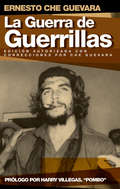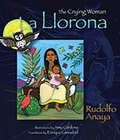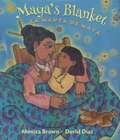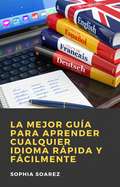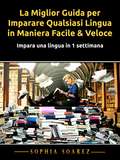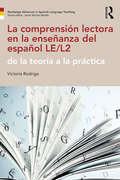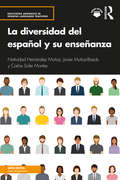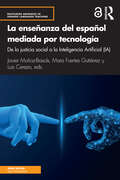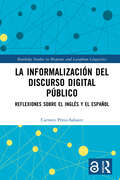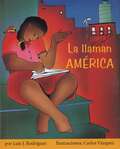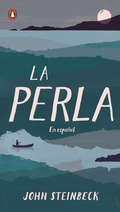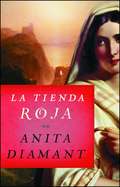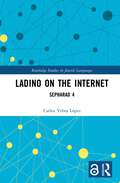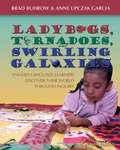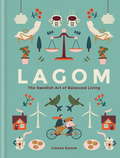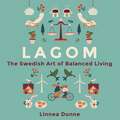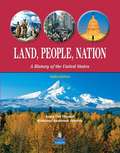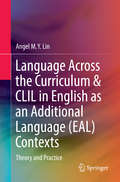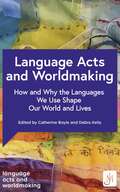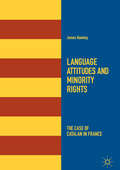- Table View
- List View
La Guerra de Guerrillas
by Ernesto Che GuevaraA bestselling Che classic for decades, this is Che Guevara's own incisive analysis of the Cuban revolution-a text studied by his admirers and adversaries alike. Here he explains how a small, dedicated group grew in strength and with the support of the Cuban people was able to defeat a dictator's army.
La Llorona: The Crying Woman
by Rudolfo A. Anaya Amy Córdova Enrique R. LamadridLa Llorona, the Crying Woman, is the legendary creature who haunts rivers, lakes, and lonely roads. Said to seek out children who disobey their parents, she has become a "boogeyman," terrorizing the imaginations of New Mexican children and inspiring them to behave. But there are other lessons her tragic history can demonstrate for children. In Rudolfo Anaya's version Maya, a young woman in ancient Mexico, loses her children to Father Time's cunning. This tragic and informative story serves as an accessible message of mortality for children. La Llorona, deftly translated by Enrique Lamadrid, is familiar and newly informative, while Amy Cordova's rich illustrations illuminate the story. The legend as retold by Anaya, a man as integral to southwest tradition as La Llorona herself, is storytelling anchored in a very human experience. His book helps parents explain to children the reality of death and the loss of loved ones.
La Mejor Guía para Aprender Cualquier Idioma Rápida y Fácilmente
by Sophia SoarezUna guía detallada para aprender un idioma de una forma fácil y rápida. Esta guía te ayudará a aprender un nuevo idioma en una semana. Te enseñará tips para convertirte en un hablante nativo. Basado en hechos científicos este libro te instruirá en: La forma más fácil para aprender un nuevo idioma Aprovechar el tiempo de una forma efectiva Convertirte en un hablante nativo Aprender pronunciaciones correctamente Posicionar la boca para la correcta pronunciación Mantenerse motivado Mejorar el acento Si quieres aprender un nuevo idioma en una semana y así convertirte en hablante nativo, entonces este post es para tí. ---Desplaza hasta arriba de la página y clickea ¨Añadir al carrito¨ para comprar instantáneamente.--- Descargo: Este autor y/o titular de derechos no hace reclamos, promesas o garantías sobre la exactitud, integridad o adecuación de los contenidos de este libro y expresamente renuncia a la responsabilidad por errores y omisiones en los contenidos dentro de ellos. Este producto es solo para referencia.
La Miglior Guida per Imparare Qualsiasi Lingua in Maniera Facile & Veloce: Impara una lingua in 1 settimana
by Sophia SoarezUna guida dettagliata per imparare qualsiasi lingua in modo facile e veloce Questa guida ti aiuterà ad imparare la nuova lingua in 1 settimana e ti insegnerà trucchi e suggerimenti per diventare madrelingua della nuova lingua. Sulla base di fatti scientifici, questo libro ti spiegherà: - il modo più semplice per imparare una nuova lingua - Come impiegare il tuo tempo in modo efficace - Come diventare un madrelingua - Come imparare la corretta pronuncia della nuova lingua - Come posizionare la bocca per una pronuncia corretta - Come memorizzare le parole di una nuova lingua - Come rimanere motivati - Come migliorare l'accento Se vuoi imparare una nuova lingua in una settimana e diventare un madrelingua, allora questo libro fa per te. -> Scorri fino all'inizio della pagina e fai clic su Aggiungi al carrello per acquistare immediatamente Disclaimer: Questo autore e / o il / i proprietario / i dei diritti non fanno rivendicazioni, promesse o garanzie circa l'accuratezza, la completezza o l'adeguatezza dei contenuti di questo libro e declina espressamente la responsabilità per errori e omissioni nei contenuti all'interno di esso. Questo prodotto è solo per riferimento.
La comprensión lectora en la enseñanza del español LE/L2: de la teoría a la práctica
by Victoria RodrigoLa comprensión lectora en la enseñanza del español LE/L2: de la teoría a la práctica presents state-of-the-art theory and teaching practices for integrating reading skills into the teaching of Spanish. The book bridges a conspicuous gap between research supporting reading as a key component of language acquisition and actual practice by discussing how to implement reading successfully in and out of the classroom. Written entirely in Spanish, the book focuses on the needs of Spanish language learners with the goal of motivating students to read in the target language and work with diverse types of texts and genres. Written in a clear and accessible manner, La comprensión lectora en la enseñanza del español LE/L2: de la teoría a la práctica is an essential resource for teachers of Spanish at all levels. It is an excellent reference book for language teachers who wish to integrate reading into the teaching of the Spanish language.
La diversidad del español y su enseñanza (Routledge Advances in Spanish Language Teaching)
by Javier Muñoz-Basols Natividad Hernández Muñoz Carlos Soler MontesLa diversidad del español y su enseñanza es la primera publicación concebida para reflexionar sobre la diversidad de la lengua desde un punto de vista crítico, interdisciplinario, institucional, aplicado e internacional. El análisis de doce lecturas y de una detallada guía de explotación didáctica potencian la adquisición de conocimientos sobre la lengua y desvelan la complejidad de la investigación sobre las variedades del español. Características principales: • Artículos de investigación desde diferentes enfoques y perspectivas; • Actividades de reflexión para verificar la asimilación de contenidos; • Análisis crítico de extractos y citas de autoridad (español e inglés); • Preguntas analíticas sobre el estado de la cuestión y recursos institucionales; • Modelos metodológicos de investigación empírica sobre la diversidad de la lengua; • Propuestas de temas para la investigación y el debate dentro y fuera del aula; • Pautas bibliográficas detalladas para profundizar sobre la materia; • Selección de conceptos clave para potenciar la adquisición de terminología lingüística; • Glosario bilingüe en línea (español e inglés) sobre variedades del español, sociolingüística aplicada y política lingüística; • Soluciones de las guías de lectura e información complementaria. Diseñado como libro de texto o material de autoaprendizaje, La diversidad del español y su enseñanza es una herramienta imprescindible para familiarizarse con la diversidad de la lengua. La información será de interés y aplicable en contextos académicos y profesionales de enseñanza, diseño curricular y elaboración de materiales didácticos de español como lengua extranjera o segunda y de herencia. Cualquier investigador, profesor, estudiante o lector podrá acceder de manera crítica y pautada a esta importante parcela de conocimiento sobre el idioma. La diversidad del español y su enseñanza brings together twelve articles that investigate Spanish linguistic variation and the impact this has on Spanish language teaching. Based on a special edition of the Journal of Spanish Language Teaching, each chapter here presents an article from the Journal with an additional reading guide designed to transform the information into a pedagogical tool that can be used and applied in the classroom. Each article is accompanied by critical analysis, reflection activities, questions for future research and debate, and suggestions for further reading. A bilingual glossary covering key terms within Spanish language variation, applied sociolinguistics and language policy is available online at www.routledge.com/9780367651695. This book is a practical overview of the evolution and current state of the study of Spanish language variation and will be of most interest to researchers and teachers of Spanish as a second language who will gain insight into how to include linguistic variation in their teaching.
La enseñanza del español mediada por tecnología: de la justicia social a la Inteligencia Artificial (IA) (Routledge Advances in Spanish Language Teaching)
by Luis Cerezo Javier Muñoz-Basols Mara Fuertes GutiérrezLa enseñanza del español mediada por tecnología ofrece una nutrida panorámica de la investigación actual y de las estrategias didácticas sobre la integración de la tecnología en la enseñanza y el aprendizaje del español. Estructurado en trece capítulos esenciales, el libro constituye una hoja de ruta diseñada para que los profesionales de la lengua incorporen de manera eficaz la tecnología en cualquier entorno de aprendizaje: presencial, híbrido o en línea. Características principales: • marco metodológico Planificar, Personalizar e Implementar (PPI) con elementos teóricos y prácticos sobre tecnología y enseñanza de lenguas; • selección de temas: accesibilidad, diseño curricular, actitudes de los docentes y diversidad; estrategias para gestionar la motivación, ansiedad, interacción y feedback; pautas para gestionar la enseñanza híbrida y en línea, inmersión lingüística digital, podcasts y narraciones digitales; gamificación e Inteligencia Artificial (IA); • estructura consistente: conceptos clave, directrices metodológicas, consideraciones prácticas y referencias adicionales; • estrategias pedagógicas para apoyar la enseñanza de lenguas mediada por tecnología. Escrito por un elenco internacional de investigadores, el libro es un recurso único para incorporar prácticas eficientes en la enseñanza de idiomas mediada por tecnología.
La enseñanza del español mediada por tecnología: de la justicia social a la Inteligencia Artificial (IA) (Routledge Advances in Spanish Language Teaching)
by Luis Cerezo Javier Muñoz-Basols Mara Fuertes GutiérrezLa enseñanza del español mediada por tecnología ofrece una nutrida panorámica de la investigación actual y de las estrategias didácticas sobre la integración de la tecnología en la enseñanza y el aprendizaje del español. Estructurado en trece capítulos esenciales, el libro constituye una hoja de ruta diseñada para que los profesionales de la lengua incorporen de manera eficaz la tecnología en cualquier entorno de aprendizaje: presencial, híbrido o en línea.Características principales: marco metodológico Planificar, Personalizar e Implementar (PPI) con elementos teóricos y prácticos sobre tecnología y enseñanza de lenguas selección de temas: accesibilidad, diseño curricular, actitudes de los docentes y diversidad; estrategias para gestionar la motivación, ansiedad, interacción y feedback; pautas para gestionar la enseñanza híbrida y en línea, inmersión lingüística digital, podcasts y narraciones digitales; gamificación e Inteligencia Artificial (IA) estructura consistente: conceptos clave, directrices metodológicas, consideraciones prácticas y referencias adicionales estrategias pedagógicas para apoyar la enseñanza de lenguas mediada por tecnología Escrito por un elenco internacional de investigadores, el libro es un recurso único para incorporar prácticas eficientes en la enseñanza de idiomas mediada por tecnología.La enseñanza del español mediada por tecnología offers a thorough exploration of current research and instructional strategies related to the integration of technology into the teaching and learning of Spanish. It consists of thirteen chapters that serve as a roadmap designed for language professionals to effectively incorporate technology into their learning environments: face-to-face, hybrid, or fully online.Key features: Three major sections presented as a framework, Planning, Personalizing and Implementing (PPI), that blend both theoretical and practical elements of technology; A unique range of topics, such as accessibility, curriculum development, teachers' beliefs and diversity; strategies for managing motivation, anxiety, interaction, and feedback; tips for effective hybrid and online teaching, digital language immersion, use of podcasts and digital storytelling, gamification, and Artificial Intelligence (AI); A consistent format for all chapters, with key concepts, methodological guidelines, practical considerations, and references for further exploration of each topic covered; Clear explanations and numerous scenarios that help readers comprehend the various factors that influence technology-assisted language learning; Support for educators in navigating the challenges that arise in technology-enhanced learning and teaching, with a focus on pedagogical best practices; Tips for educators to transition from a conventional curriculum approach to a more creative and engaging one that maximizes learning opportunities mediated by technology. Written by an international team of scholars, La enseñanza del español mediada por tecnología is a unique resource for Spanish language professionals at any context who wish to improve and enhance their teaching techniques. The book will be equally valuable to teachers of other languages as it contains relevant material on best practices and classroom management in technology-mediated education.
La historia de Maita
by Mario Vargas LlosaNovela ácida y quijotesca, versión lúcida, amarga y tragicómica de los maximalismos revolucionarios y la nostalgia de la epopeya. En Historia de Mayta se cuenta la historia de Alejandro Mayta, militante de un grupo troskista peruano, en el año 1958, cuando el derrumbamiento del imperio colonial francés en Indochina proporcionaba esperanzas y motivos de controversias a los activistas de la clandestinidad. En el relato se narra la investigación de un escritor, fascinado por el carisma de Mayta, cuando ha transcurrido un cuarto de siglo desde que el revolucionario desapareciera. Vargas Llosa moviliza a sus personajes para llegar al espacio donde es posible conocer el verdadero rostro del ser humano. Mediante un relato nutrido de sus declaraciones, expuesto como una epopeya oral, una declaración política, una sátira y un gran documental histórico, Mayta aparecerá como un héroe y un malvado, un místico y un traidor, como enamorado de las mujeres, reprimido romántico, predicador diabólico y doctrinario casto. La novela se convierte así en la crónica de una búsqueda apasionante, anticipo de Lituma en los Andes y La fiesta del chivo.
La informalización del discurso digital público: Reflexiones sobre el inglés y el español (Routledge Studies in Hispanic and Lusophone Linguistics)
by Carmen Pérez-SabaterLa informalización del discurso digital público is an innovative volume which examines different communicative practices which take place on social media and justifies the shift towards more informal/oral styles of public communication in English and Spanish.The book takes a first step in understanding and analysing how the use of code-switching, language preference, and graphicons contribute to the public image of institutions, politicians and celebrities, as well as how the aforementioned strategies fit into the negotiation of the norms and identities of public communities on social media platforms. Offering an updated approach to studying digital discourse in public contexts, it is the first of its kind written in Spanish. The volume focuses on the characteristic linguistic features associated with digital communication and informal oral writing styles, such as reduplication of vowels, consonants, acronyms, and shortenings, code-switching and language preference, and the insertion of multimodal and graphical elements.A comprehensive and unique volume, La informalización del discurso digital público is ideal for researchers and postgraduate students interested in digital discourse, sociolinguistics, and media studies.Chapter 5 of this book is freely available as a downloadable Open Access PDF at http://www.taylorfrancis.com under a Creative Commons Attribution-Non Commercial-No Derivatives (CC-BY-NC-ND) 4.0 license.La informalización del discurso digital público es un volumen innovador que examina diferentes prácticas comunicativas que tienen lugar en las redes sociales con el fin de justificar el cambio hacia estilos más informales/orales de comunicación pública en inglés y en español.El libro ofrece un punto de vista novedoso sobre la contribución del cambio de código, la elección de lengua y los graficonos a la imagen pública de instituciones, políticos y celebridades; así como la repercusión que las estrategias mencionadas tienen en la negociación de las normas e identidades de las comunidades públicas en redes sociales. Ofrece un enfoque actualizado del estudio del discurso digital en contextos públicos y es el primero de este tipo escrito en español. El volumen se centra en los rasgos lingüísticos característicos de la comunicación digital y de los estilos de escritura oral informal, tales como la reduplicación de vocales, consonantes, acrónimos y abreviaturas, el cambio de código y la preferencia de lengua, así como la inserción de elementos multimodales y gráficos.La informalización del discurso digital público es un volumen completo y único, ideal para investigadores y estudiantes de posgrado interesados en el discurso digital, la sociolingüística y los estudios sobre los medios de comunicación.Chapter 5 of this book is freely available as a downloadable Open Access PDF at http://www.taylorfrancis.com under a Creative Commons Attribution-Non Commercial-No Derivatives (CC-BY-NC-ND) 4.0 license.
La llaman América
by Luis J. RodríguezUna niña de nueve años, América Soliz, vive con su familia en el Barrio Pilsen de Chicago. Echa de menos su hogar en México y se siente descontenta en la escuela, donde experimenta el prejuicio contra los inmigrantes mexicanos. América se siente en la fila de atrás del salón de clase y se la pasa soñando con su aldea en Oaxaca hasta que un día un poeta, el Sr. Aponte, visita la clase. "Todos llevamos le poesía por dentro," le dice el Sr. Aponte a la clase e inspira a América a escribir. "Escriban en español o en inglés," exhorta él. América escribe cuentos y poemas, aun cuando su padre dice que es una manera poco práctica de utilizar el tiempo. Tanto el tío como la madre de América disfrutan los cuentos de la chica, y ésta descubre para sí lo que el Sr. Aponte ha dicho en clase. "Cuando se usan las palabras para compartir los sentimientos con otra persona se es poeta y los poetas pertenecen a todo el mundo." A través de la escritura, América se siente "en casa" en el Barrio Pilsen.
La mitad del alma
by Carme RieraPREMIO NACIONAL DE LAS LETRAS 2015 Una investigación sobre un pasado familiar, una búsqueda que traspasa las páginas y se sitúa en el ámbito del lector, al que se recurre para resolver el enigma y para poner un final a la trama. ¿Cómo reaccionaría usted si, de repente, un desconocido le entregara unos papeles que cuestionan sus orígenes, que parecen probar que su identidad es falsa? Esto es lo que sucede en este relato que se inicia con la búsqueda de los antecedentes familiares de la narradora, una investigación que supera los planes de la novela -de la ficción- para adentrarse en la realidad extraliteraria. Y así, la protagonista, desde las primeras páginas del libro, pedirá ayuda a los lectores, después de haber agotado todas las vías posibles en la vida real, por si alguien puede aportar datos sobre el caso de Cecilia Balaguer, o de Celia Ballester -también usaba este nombre-, desaparecida entre el 1 y el 4 de enero de 1960, en la población fronteriza de Portbou...
La nevada del Cucut
by Blanca BusquetsUna dona que va viure fa cent anys escriu damagat a la llum duna espelma en un lloc perdut de Catalunya. Les seves lletres la lligaran amb fil invisible a una altra dona del segle XXI que tampoc pot viure sense escriure. Tan sols elles dues veuen un poble nevat en un quadre que aparentment només té taques...Lart i les lletres, però també el dolor i sentiments molt intensos, són el que portarà aquestes dues dones a patir com ningú, però també a viure plenament la vida, probablement també com ningú lha viscut.Una història que no podràs deixar de lleguir, uns personatges que estimarás, una novel·la que no podràs oblidar.
La perla: En español (Spanish Language Edition of The Pearl) (Novela/edhasa Ser. #Vol. 18)
by John SteinbeckSteinbeck's classic cautionary tale, now in an accessible new Spanish-language translationOne of Steinbeck's most taught works, The Pearl is the story of the Mexican diver Kino, whose discovery of a magnificent pearl from the Gulf beds means the promise of a better life for his impoverished family. His dream blinds him to the greed and suspicions the pearl arouses in him and his neighbors, and even his loving wife Juana cannot temper his obsession or stem the events leading to tragedy. This classic novella from Nobel Prize-winner John Steinbeck examines the fallacy of the American dream, and illustrates the fall from innocence experienced by people who believe that wealth erases all problems.
La tienda roja
by Anita DiamantProfundamente conmovedora, La tienda roja combina una rica historia con el valor de la ficción moderna: una nueva visión de la sociedad bíblica femenina.Su nombre era Dina y en la Biblia apenas se la menciona para referirse a un violento suceso de venganza que protagonizaron su padre, Jacob, y sus hermanos Simeón y Levi. Única hija de Jacob entre los numerosos varones que este tuvo con Lía, su primera mujer, y con sus otras tres esposas, Zilpa, Raquel y Bilha, todas ellas hijas de Laban. Dina relata su propia historia creando una autentica evocación del mundo femenino en la época del Antiguo Testamento. En aquellos tiempos, las tradiciones, las historias familiares y los conocimientos en general se perpetuaban de generación en generación por medio del linaje materno. Y el traspaso de toda esta sabiduría tenia lugar en la "tienda roja," espacio donde se recluían las mujeres cuando no podían aparecer ante los ojos de los hombres: durante los días del ciclo femenino, después de los partos y en momentos de enfermedad. Allí, Dina explicara las historias de sus "cuatro madres," a partir del día en que Jacob apareció en las tierras de su tío Laban, así como el azaroso traslado de su familia desde las Mesopotamia hasta Canaán, y mas tarde su emigración a Egipto.Pero La tienda roja no es simplemente una reconstrucción del libro del Génesis desde el punto de vista de la mujer, sino una novela histórica minuciosamente investigada que nos introduce en el riquísimo mundo de las tradiciones mas ancestrales. Todo un acopio de normas y conductas imprescindibles para la supervivencia en tierras áridas y desoladas que, además de constituir la base de las religiones judeocristianas, siguen vigentes en algunos rincones del mundo hasta el día de hoy.
Ladino on the Internet: Sepharad 4 (Routledge Studies in Jewish Languages)
by Carlos Yebra LópezLadino on the Internet constitutes the first critical and systematic account written in English on the online revitalisation of Ladino.This book conclusively demonstrates that nowadays the global Ladino-speaking community connects first and foremost online, which calls for a full, comprehensive examination of the web-based development of the Sephardic diaspora (including that of Ladino) as a qualitatively different stage, termed ‘Sepharad 4’ in this monograph.Drawing upon the methodological framework of Revivalistics and including a comparative analysis with similar initiatives apropos Yiddish, this volume analyses case studies including YouTube digital archives, social media platforms, language learning apps, online schools, and Ladino on Netflix, plus on Web 3.0 platforms.This monograph will appeal to scholars and postgraduate students seeking to familiarise themselves with the use of technological tools to further the revitalisation of endangered languages such as Ladino.
Ladybugs, Tornadoes, and Swirling Galaxies: English Language Learners Discover Their World Through Inquiry
by Brad Buhrow Anne Upczak GarciaYou will see how the authors blend comprehension instruction and ELL best practices to explore inquiry as a literacy pathway for English language learners. As teachers and students engage in learning science and social studies content they also discover multiple ways to make meaning. The book is full of photographs of student artwork--including a color insert--that reveals the children's inquiry process, and demonstrates the important role of art as a sign system in ELL literacy and language acquisition. Brad and Anne provide explicit detail on the process they use as they move step-by-step with students from personal narrative through the independent inquiry process. They also discuss use of the Gradual Release Model, authentic assessment, and bilingual identities. Appendices in Spanish and English help to round out this informative and charming resource.
Lagom: The Swedish Art of Balanced Living
by Linnea DunneStep aside Hygge. Lagom is the new Scandi lifestyle trend taking the world by storm. This delightfully illustrated book gives you the lowdown on this transformative approach to life and examines how the lagom ethos has helped boost Sweden to the No.10 ranking in 2017's World Happiness Report. Lagom (pronounced 'lah-gom') has no equivalent in the English language but is loosely translated as 'not too little, not too much, just right'. It is widely believed that the word comes from the Viking term 'laget om', for when a mug of mead was passed around a circle and there was just enough for everyone to get a sip. But while the anecdote may hit the nail on the head, the true etymology of the word points to an old form of the word 'lag', which means 'law'.Far from restrictive, lagom is a liberating concept, praising the idea that anything more than 'just enough' is a waste of time. Crucially it also comes with a selflessness and core belief of responsibility and common good. By living lagom you can: Live a happier and more balanced life Reduce your environmental impact Improve your work-life balance Free your home from clutter Enjoy good food the Swedish way Grow your own and learn to forage Cherish the relationships with those you love
Lagom: The Swedish Art of Balanced Living
by Linnea DunneDiscover the Swedish ethos of balanced living with Lagom.Lagom (pronounced 'lar-gom') has no equivalent in the English language but is loosely translated as 'not too little, not too much, just right'. It is widely believed that the word comes from the Viking term 'laget om', for when a mug of mead was passed around a circle and there was just enough for everyone to get a sip. But while the anecdote may hit the nail on the head, the true etymology of the word points to an old form of the word 'lag', which means 'law'.Far from restrictive, lagom is a liberating concept, praising the idea that anything more that 'just enough' is a waste of time. Crucially it also comes with a selflessness and core belief of responsibility and common good. By living lagom you can live a happier and more balanced life, reduce your environmental impact, improve your work-life balance, free your home from clutter, enjoy good food the Swedish way, grow your own and learn to forage, and cherish the relationships with those you love.Linnea Dunne was born and raised in Sweden, where she started her writing career as a columnist at the local newspaper aged 15. She left for Ireland a few years later and eventually moved to London, where she studied Creative Writing and Political Communications. She now lives in Dublin with her husband and two half-Swedish kids, trying to achieve that lagom balance against all odds. Linnea's work on subjects ranging from motherhood to women's rights and media narratives has been published by (among others) the Irish Times, the Guardian and the Irish Independent, and she also works as Editor of Scan Magazine. The irony of the fact that she escaped her home country, never made it back, and now spends the majority of her day writing about Scandinavian culture, innovation and trends is lost on no one.(P) 2017 Octopus Publishing Group
Land, People, Nation: A History of the United States (3rd Edition)
by Anna Uhl Chamot Kathleen Anderson SteevesLand, People, Nation: A History of the United States helps English language learners and struggling readers develop academic language skills for learning history and geography. The engaging readings and illustrations, maps, charts, and graphs build valuable interpretive skills for students as they master academic content.
Language Across the Curriculum & CLIL in English as an Additional Language (EAL) Contexts
by Angel M. Y. LinThis book will be of interest to a broad readership, regardless of whether they have a background in sociolinguistics, functional linguistics or genre theories. It presents an accessible "meta-language" (i. e. a language for talking about language) that is workable and usable for teachers and researchers from both language and content backgrounds, thus facilitating collaboration across content and language subject panels. Chapters 1 to 3 lay the theoretical foundation of this common meta-language by critically reviewing, systematically presenting and integrating key theoretical resources for teachers and researchers in this field. In turn, Chapters 4 to 7 focus on issues in pedagogy and assessment, and on school-based approaches to LAC and CLIL, drawing on both research studies and the experiences of front-line teachers and school administrators. Chapter 8 provides a critical and reflexive angle on the field by asking difficult questions regarding how LAC and CLIL are often situated in contexts characterized by inequality of access to the linguistic and cultural capitals, where the local languages of the students are usually neglected or viewed unfavourably in relation to the L2 in mainstream society, and where teachers are usually positioned as recipients of knowledge rather than makers of knowledge. In closing, Chapter 9 reviews the state of the art in the field and proposes directions for future inquiry.
Language Acts and Worldmaking: How and Why the Languages We Use Shape Our World and Our Lives
byCollectively authored by the Language Acts and Worldmaking team, this defining volume offers reflective narratives on research, theory and practice over the course of the flagship project of the same name, funded by the Arts and Humanities Research Council's Open World Research Initiative. It returns to the project's key principles - that our words make worlds and we are agents in worldmaking - analyses the practices and outcomes of collaborative working, and looks to the future by offering concrete ideas for how the work they have done can now continue to do its work in the world.Focusing on the key research strands, this volume looks at the role of the language teacher as a mediator between languages and cultures, worldmaking in modern languages, translation and the imagination, languages and hospitality, digital mediations, and how words change and make worlds. Critically, it analyses the impact on communities of living in multilingual cities, and the ways in which learning a first language, and then a second, and so on, plays a crucial role in our ability to understand our culture in relation to others and to appreciate the ways in which they are intertwined.Specific aims are to: · propose new ways of bridging the gaps between those who teach and research languages and those who learn and use them in everyday contexts from the professional to the personal · put research into the hands of wider audiences · share a philosophy, policy and practice of language teaching and learning which turns research into action · provide the research, experience and data to enable informed debates on current issues and attitudes in language learning, teaching and research · share knowledge across and within all levels and experiences of language learning and teaching · showcase exciting new work that derives from different types of community activity and is of practical relevance to its audiences · disseminate new research in languages that engages with diverse communities of language practitioners.
Language Acts and Worldmaking: How and Why the Languages We Use Shape Our World and Our Lives
byCollectively authored by the Language Acts and Worldmaking team, this defining volume offers reflective narratives on research, theory and practice over the course of the flagship project of the same name, funded by the Arts and Humanities Research Council's Open World Research Initiative. It returns to the project's key principles - that our words make worlds and we are agents in worldmaking - analyses the practices and outcomes of collaborative working, and looks to the future by offering concrete ideas for how the work they have done can now continue to do its work in the world.Focusing on the key research strands, this volume looks at the role of the language teacher as a mediator between languages and cultures, worldmaking in modern languages, translation and the imagination, languages and hospitality, digital mediations, and how words change and make worlds. Critically, it analyses the impact on communities of living in multilingual cities, and the ways in which learning a first language, and then a second, and so on, plays a crucial role in our ability to understand our culture in relation to others and to appreciate the ways in which they are intertwined.Specific aims are to: · propose new ways of bridging the gaps between those who teach and research languages and those who learn and use them in everyday contexts from the professional to the personal · put research into the hands of wider audiences · share a philosophy, policy and practice of language teaching and learning which turns research into action · provide the research, experience and data to enable informed debates on current issues and attitudes in language learning, teaching and research · share knowledge across and within all levels and experiences of language learning and teaching · showcase exciting new work that derives from different types of community activity and is of practical relevance to its audiences · disseminate new research in languages that engages with diverse communities of language practitioners.
Language Attitudes and Minority Rights: The Case Of Catalan In France
by James HawkeyThis book presents a detailed sociolinguistic study of the traditionally Catalan-speaking areas of Southern France, and sheds new light on language attitudes, phonetic variation, language ideologies and minority language rights. The region’s complex dual identity, both Catalan and French, both peripheral and strategic, is shown to be reflected in the book’s attitudinal findings which in turn act as reliable predictors of phonetic variation. The author’s careful discursive analysis paints a clear picture of the linguistic ideological landscape: in which French dominates as the language of status and prestige. This innovative work, employing cutting-edge mixed methods, provides an in-depth account of an under-examined language situation, and draws on this research to propose a number of policy recommendations to protect minority rights for speakers of Catalan in the region. Combining language attitudes, sociophonetics, discourse studies, and language policy, this will provide an invaluable reference for scholars of French and Catalan studies and minority languages around the world.
